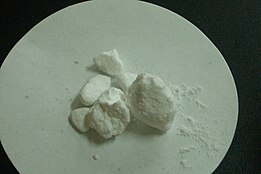
| |
 Unit cell of tripotassium phosphate. | |
| Names | |
|---|---|
| IUPAC name Potassium phosphate | |
| Systematic IUPAC name Potassium tetraoxidophosphate(3−) | |
| Other names Potassium phosphate, tribasic | |
| Identifiers | |
| CAS Number | |
| 3D model (JSmol) | |
| ChEBI | |
| ChemSpider | |
| ECHA InfoCard | 100.029.006 |
| EC Number |
|
| E number | E340(iii) (antioxidants, ...) |
| PubChem CID | |
| UNII | |
| CompTox Dashboard (EPA) | |
InChI
| |
SMILES
| |
| Properties | |
| Chemical formula | K3PO4 |
| Molar mass | 212.27 g/mol |
| Appearance | White deliquescent powder |
| Density | 2.564 g/cm (17 °C) |
| Melting point | 1,380 °C (2,520 °F; 1,650 K) |
| Solubility in water | 90 g/100 mL (20 °C) |
| Solubility in ethanol | Insoluble |
| Basicity (pKb) | 1.6 |
| Structure | |
| Crystal structure | Primitive orthorhombic |
| Space group | Pnma, No. 62 |
| Lattice constant | a = 1.123772 nm, b = 0.810461 nm, c = 0.592271 nm |
| Hazards | |
| Occupational safety and health (OHS/OSH): | |
| Main hazards | Irritant |
| GHS labelling: | |
| Pictograms | 
|
| Signal word | Warning |
| Hazard statements | H319 |
| Precautionary statements | P264, P280, P305+P351+P338, P337+P313 |
| NFPA 704 (fire diamond) |
 |
| Flash point | Non-flammable |
| Safety data sheet (SDS) | MSDS |
| Related compounds | |
| Other cations | Trisodium phosphate Triammonium phosphate Tricalcium phosphate |
| Related compounds | Monopotassium phosphate Dipotassium phosphate |
| Except where otherwise noted, data are given for materials in their standard state (at 25 °C , 100 kPa).
| |
Tripotassium phosphate, also called tribasic potassium phosphate is a water-soluble salt with the chemical formula K3PO4(H2O)x (x = 0, 3, 7, 9). Tripotassium phosphate is basic: a 1% aqueous solution has a pH of 11.8.
Production
Tripotassium phosphate is produced by the neutralization of phosphoric acid with potassium hydroxide:
- H3PO4 + 3KOH → K3PO4 + 3H2O
Use in organic chemistry

Tripotassium phosphate has few industrial applications, however it is commonly used as a base in laboratory-scale organic chemistry. Being insoluble in organic solvents, it is an easily removed proton acceptor in organic synthesis. The anhydrous salt is especially basic. Some of the reactions are listed below:
- The hydrate (K3PO4·H2O) has been used to catalyze the deprotection of BOC amines. Microwave radiation is used to aid the reaction.
- As a catalyst for the synthesis of unsymmetrical diaryl ethers using as the solvent. Aryl methane-sulfonates are deprotected and then followed by a nucleophilic aromatic substitution (SNAr) with activated aryl halides.
- As a base in the cross-coupling reaction of aryl halides with terminal alkynes. It also plays a role in the deacetonation of 4-aryl-2-methylbut-3-yn-2-ol intermediates.
- As the base in the cross-coupling reaction between aryl halides and phenols or aliphatic alcohols.
Use in foods
Tripotassium phosphate can be used in foods as a buffering agent, emulsifying agent, and for nutrient fortification. It can serve as a sodium-free substitute for trisodium phosphate. The ingredient is most common in dry cereals but is also found in meat, sauces, and cheeses.
References
- ^ Voronin, V. I.; Ponosov, Yu. S.; Berger, I. F.; Proskurnina, N. V.; Zubkov, V. G.; Tyutyunnik, A. P.; Bushmeleva, S. N.; Balagurov, A. M.; Sheptyakov, D. V.; Burmakin, E. I.; Shekhtman, G. Sh.; Vovkotrub, E. G. (2006). "Crystal structure of the low-temperature form of K3PO4". Inorganic Materials. 42 (8): 908–913. doi:10.1134/S0020168506080206. S2CID 92351896.
- "Potassium phosphate". pubchem.ncbi.nlm.nih.gov.
- "Potassium phosphate tribasic P5629". Sigma-Aldrich. Retrieved 2018-04-27.
- ^ Klaus Schrödter; Gerhard Bettermann; Thomas Staffel; Friedrich Wahl; Thomas Klein; Thomas Hofmann (2012). "Phosphoric Acid and Phosphates". Ullmann's Encyclopedia of Industrial Chemistry. Weinheim: Wiley-VCH. doi:10.1002/14356007.a19_465.pub3. ISBN 978-3527306732.
- Chiong, Hendrich A. (2010). "Potassium Phosphate". Encyclopedia of Reagents for Organic Synthesis. doi:10.1002/047084289X.rn01172. ISBN 978-0-471-93623-7.
- Dandepally, Srinivasa Reddy; Williams, Alfred L. (2009-03-04). "Microwave-assisted N-Boc deprotection under mild basic conditions using K3PO4·H2O in MeOH". Tetrahedron Letters. 50 (9): 1071–1074. doi:10.1016/j.tetlet.2008.12.074. ISSN 0040-4039.
- Xu, Hui; Chen, Yang (2007-04-30). "C(aryl)-O Bond Formation from Aryl Methanesulfonates via Consecutive Deprotection and SNAr Reactions with Aryl Halides in an Ionic Liquid". Molecules. 12 (4): 861–867. doi:10.3390/12040861. PMC 6149384. PMID 17851438.
- Shirakawa, Eiji; Kitabata, Takaaki; Otsuka, Hidehito; Tsuchimoto, Teruhisa (2005-10-10). "A simple catalyst system for the palladium-catalyzed coupling of aryl halides with terminal alkynes". Tetrahedron. 61 (41): 9878–9885. doi:10.1016/j.tet.2005.07.099. ISSN 0040-4020.
- Niu, Jiajia; Zhou, Hua; Li, Zhigang; Xu, Jingwei; Hu, Shaojing (2008-10-03). "An Efficient Ullmann-Type C−O Bond Formation Catalyzed by an Air-Stable Copper(I)−Bipyridyl Complex". The Journal of Organic Chemistry. 73 (19): 7814–7817. doi:10.1021/jo801002c. ISSN 0022-3263. PMID 18771324.
- Han, James (2020-08-03). "What is Tripotassium Phosphate E340(iii) in Food and Functions in Cereals?". foodadditives.net. Retrieved 2022-12-22.
| Potassium compounds | |
|---|---|
| H, (pseudo)halogens | |
| chalcogens | |
| pnictogens | |
| B, C group | |
| transition metals | |
| organic | |
| Phosphates | ||||||||||||||||||||||||||||||||||||||||||||||||||||||||||||||||||||||||||||||||||||||||||||||||||||||||||||||||||||||||||||||||||||||||||||||||||||||||||||||||||||
|---|---|---|---|---|---|---|---|---|---|---|---|---|---|---|---|---|---|---|---|---|---|---|---|---|---|---|---|---|---|---|---|---|---|---|---|---|---|---|---|---|---|---|---|---|---|---|---|---|---|---|---|---|---|---|---|---|---|---|---|---|---|---|---|---|---|---|---|---|---|---|---|---|---|---|---|---|---|---|---|---|---|---|---|---|---|---|---|---|---|---|---|---|---|---|---|---|---|---|---|---|---|---|---|---|---|---|---|---|---|---|---|---|---|---|---|---|---|---|---|---|---|---|---|---|---|---|---|---|---|---|---|---|---|---|---|---|---|---|---|---|---|---|---|---|---|---|---|---|---|---|---|---|---|---|---|---|---|---|---|---|---|---|---|---|
| ||||||||||||||||||||||||||||||||||||||||||||||||||||||||||||||||||||||||||||||||||||||||||||||||||||||||||||||||||||||||||||||||||||||||||||||||||||||||||||||||||||
 as the solvent. Aryl methane-sulfonates are deprotected and then followed by a
as the solvent. Aryl methane-sulfonates are deprotected and then followed by a